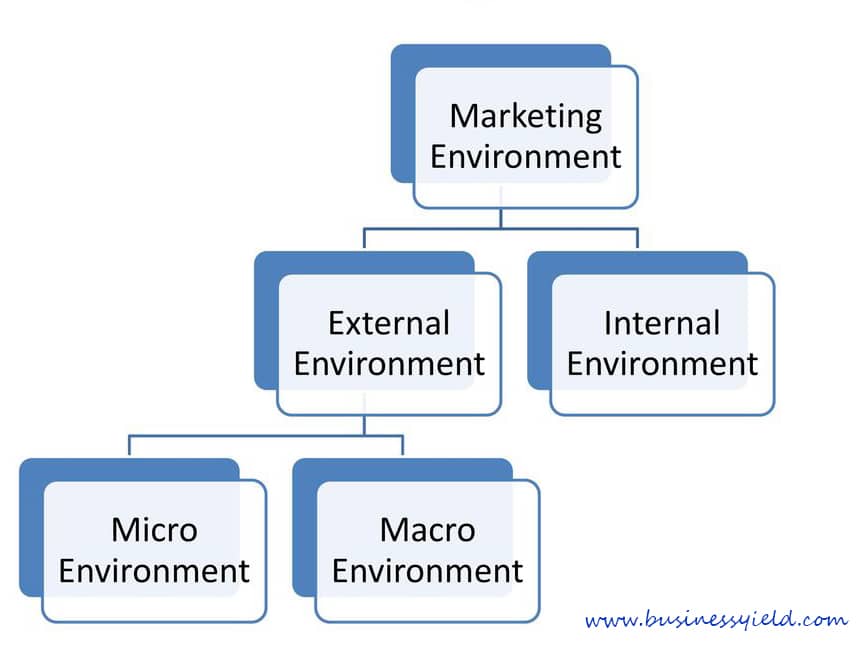If you take a quick look back, you’ll notice that even in our non-business lives, we make a lot of mistakes because we ignore our surroundings. These errors can cause significant damage, and at the other end of the spectrum, they can lead to death. In business, a company can neglect its environment to such an extent that it leads to its demise, particularly its marketing environment.
As you might have figured out, the marketing environment are forces that a company must not act against in order to stay profitable in business and at the least maintain an expectant market valuation. Let’s take a peek on an example of the marketing environment. A commercial-scale farm that plants crops throughout the year. If it’s based in sub-Saharan Africa and depends on rainwater for irrigation, it’s faced with drought during the dry season. The changing season is a natural force here. And the farm-owner has to provide a source of irrigation during the drought period else profit will plummet.
The list below highlight the concept of the marketing environment
#1. Factors that Affect Businesses:
This perhaps ranks highest among all the concepts of the marketing environment. The basic idea is if you can’t influence the market let the market influence you. Decisions you made and those made by other establishments can affect your marketing environment and considering this you don’t go against the tide, always go with the big numbers. This is one major marketing concept for small business
#2. Effect of Time
Timely intervention is paramount in every aspect of life. In most organizations, there is a penalty for the lateness this also applies in the marketing environment. Any change in your marketing environment should be acted upon aggressively and if you ain’t proficient in the new change at that time, hire skilled people so you don’t fill the market with shabby products.
#3. Power of the Unexpected:
If you are a Forex trader then you’d probably been hit by the reality of this. Watchful waiting, you have to be doing that. Therefore avoid complacency and the thought that you’re in control of your market. Nokia is a good victim of this.
READ ALSO: WHY NOKIA FAILED AND 4 WAYS TO PROTECT YOUR BUSINESS
Components of Marketing Environment
Let’s talk about the components of the marketing environment. As you are aware, how a company responds to the forces affecting its market environment is a significant determinant of its prospects. These forces can be broadly divided into two main components. The internal and external environments.
The Internal Environment
The internal environment, as a component of the marketing environment, is an important force within the boundaries of a company. Let’s break it down with these 5Ms. Men, money, Machinery, materials, marketing strategy.
#1. Men
An efficient and effective workforce with a good work ethic and interpersonal relationship is handy if you must have a decisive advantage over your competitors in the market. And each person in every department must work with the concept of the marketing environment in their mind.
#2. Money
Yeah, you need a good budget for the finance at your disposal as this will help in your marketing and sales activities. For example, a small business that can’t afford a full-fledged in-house marketing team can resort to hiring outside contractors.
#3. Machinery
You can have the best team in the world but with a below standard working tool. They will find it difficult to squeeze out good success from the market cos this will affect their efficiency.
#4. Materials
You should work hard always to deliver products that are appealing to your customers. Therefore, make improvements, introduce innovations, and retain the ones that sustain the audiences’ interest. Google is a good example of this, they make too many innovations, after some years they archive the ones that didn’t thrive well in the market and keep those that are doing a great job.
#5. Marketing Strategy
A comprehensive review of marketing strategies should be done by businesses from time to time to know the ones that are most compatible with their marketing environment.
Read Also: CPA Marketing Guide 2020 (+ Free Course)The External Environment
The external environment consists of factors outside the boundaries of the company. The factors that are under this component of marketing environment would be further divided into the micro and macro external environment. These 2 components of the external marketing environment are not as within control of the business owner as the internal marketing environment. So, Let’s take a good look at them.
Micro Component of the External Marketing Environment
This component of the external marketing environment consists of factors that are usually directly related but outside the boundaries of the company. It consists of customers, partners, and competitors.
#1. Signature
The signature phrase of Jeff Bezos when he started Amazon.com was ‘customer obsession’. Consequently, he would place an empty chair, which is a symbol of the customer, in company meetings reminding major decision-makers the role of the customer. So, you need to understand your customers, create campaigns properly targeted at them, and most importantly, provide a good customer care service that will help ingrain your business as part of their daily life.
#2. Partners
These refer to marketing intermediaries, financiers, and advertising agencies. Marketing intermediaries are people that help promote, sell, and distribute their products to final buyers. They include resellers, physical distribution firms, and financial intermediaries.
#3. Competitors
A company must have a good understanding of the big boys in their industry and know their position relative to these big boys. They can learn from these guys and even develop strategic advantages over them. Having gone through the micro-component of the external marketing environment let’s progress to the macro-component of the external marketing environment.
Macro Component of the External Marketing Environment
This component is the furthest away from the control of a firm, it consists of factors that affect the whole industry where a company functions. They include demography, economy, natural forces, technology, politics, and culture.
#1. Demography
A shoe manufacturing company produces kids’ shoes in quantities much larger than the real population of that age range in the market. Now, the end result of this is chaos, but it happens, folks. So a business ought to consistently update itself with the relevant demographic data of its market.
#2. Economy
Investment rates, inflation rates, exchange rates influence the marketing environment. Individuals will buy products when they can afford it. Inflation weakens the purchasing power of currency and this can have a crippling effect in a market.
#3. Natural Forces
The annual report of the British Petroleum plc as at the end of 2013 on proved global oil reserves estimates that the earth has nearly 1.688 trillion barrels of crude. Afterward, companies in the industry started reacting to discover new oils by application of A.I. This is a good example of natural forces affecting the whole industry in a marketing environment.
#4. Politics
Big companies that lobby the legislatures of different countries understand this very well. Because it will result in the legislature enacting laws that help them thrive.
Read also: MARKETING DEPARTMENT: Overview, structure, roles, expectations (+free tips)Marketing Environment Analysis
So, now you know about the concept and components of the marketing environment. But how do you get a good grip on these forces? It’s not so hard. With this in mind, let’s talk about marketing environment analysis. Since the employer can control his internal environment but has less control over the external environment. Market environment analysis tools are available to help with the external environment. So, there are lots of these tools. But the PESTLE tool is the most popular because of its simplicity and efficiency. In fact, some small businesses use just the PEST tool, which is simpler. Now, we’re going to list the things to consider under each factor in the PESTLE market analysis tool.
#1. Politics
Future government stability, foreign government policies, the extent of government involvement in trade unions, tax laws.
#2. Economic Factors
Labor cost, interest rates, fiscal and monetary policy, stock market trends, inflation rate, exchange rate.
#3. Social Factors
Buying behavior, income level, family size, and attitude towards saving and investment.
#4. Technological Factors
Rate of technological advancement, communication infrastructure.
#5. Legal Factors
Consumer protection laws, employee protection laws, Government procurement laws, and laws of health and safety at the workplace.
Importance of Marketing Environment
No matter what. Don’t let this knowledge slip out of your mind, “moving with the tide in business has lots of benefits.” So, real quick, let’s take a look at the importance of the marketing environment.
#1. Understanding Customers
You can use any method to ingrain this importance into your head. Customers are the sole aim of every business. So if you go against them you might not like the end result.
#2. Exploiting the Trends
You never move against the trend in any industry. It is just uncool to do that.
#3. Timely Identification of Threats and Opportunities:
This importance helps the business to position itself always on a solid foundation despite what that’s going on in the market. For instance, Jeff Bezos is a good example even with the current pandemic his net-worth is rising.
#4. Understanding Competition in Your Niche:
The concept of the marketing environment helps businesses realize every opportunity presented by competition and strike decisively.
So far so good. From the concept to components, then to the importance of the marketing environment. Now the next stop is for you elite readers, that read till the end.GOOGLE: A Case Study of Successful Market Environment
This section is based on a study published on springeropen.com by Sang Kim Tran. I’m gonna highlight important areas relevant to this article.
- Operating HR is a field of science at Google. They are constantly experimenting and innovating to find the best way to satisfy employees and to help them work effectively.
- Google made an important acquisition to buy Youtube… Youtube has grown to become the world’s largest online video sharing service
- Every company wants to hire talented people to work for them… realizing this impact, Google created a distinctive corporate culture when the company attracted people from prestigious colleges around the world.
- The role of flow and building capacity for innovation… flow is the movement of information or equipment between departments, office groups, or organizations… flow plays a role in getting stakeholders involved in working creatively and innovatively… Definitely, Google gets it done very well.
Most highlights of this study show Google’s proficiency in handling their internal marketing environment. In addition:
- Google acquired Android, made it open source, created OHA (Open Handset Alliance). So, this made android to successfully rival against iOS and change the mobile phone market trends.
- Most of Google’s products are free for users further making business miserable for iOS.
Damn, Google is a class on its own.







1 comment
Hi